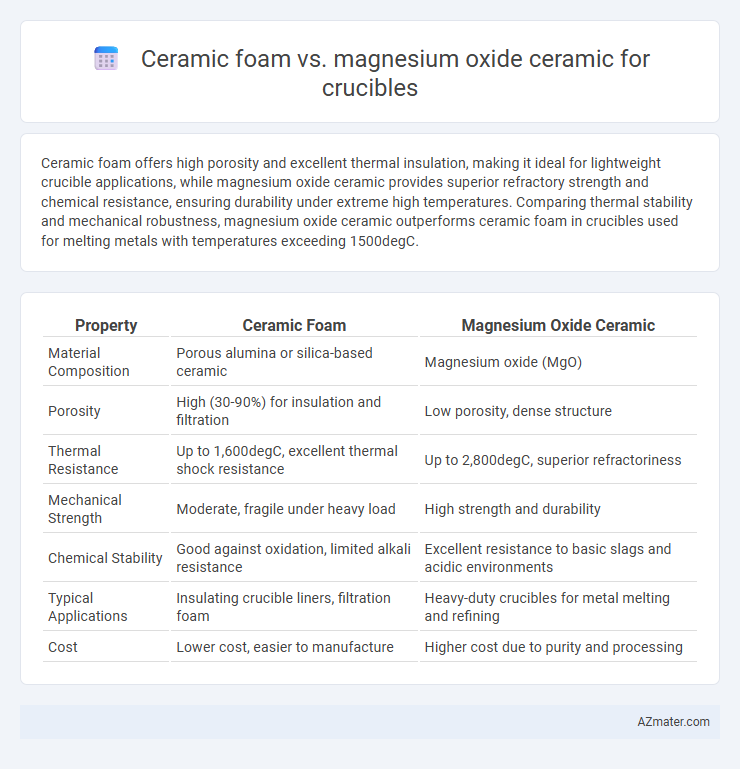Ceramic foam offers high porosity and excellent thermal insulation, making it ideal for lightweight crucible applications, while magnesium oxide ceramic provides superior refractory strength and chemical resistance, ensuring durability under extreme high temperatures. Comparing thermal stability and mechanical robustness, magnesium oxide ceramic outperforms ceramic foam in crucibles used for melting metals with temperatures exceeding 1500degC.
Table of Comparison
| Property | Ceramic Foam | Magnesium Oxide Ceramic |
|---|---|---|
| Material Composition | Porous alumina or silica-based ceramic | Magnesium oxide (MgO) |
| Porosity | High (30-90%) for insulation and filtration | Low porosity, dense structure |
| Thermal Resistance | Up to 1,600degC, excellent thermal shock resistance | Up to 2,800degC, superior refractoriness |
| Mechanical Strength | Moderate, fragile under heavy load | High strength and durability |
| Chemical Stability | Good against oxidation, limited alkali resistance | Excellent resistance to basic slags and acidic environments |
| Typical Applications | Insulating crucible liners, filtration foam | Heavy-duty crucibles for metal melting and refining |
| Cost | Lower cost, easier to manufacture | Higher cost due to purity and processing |
Introduction to Crucible Materials
Ceramic foam and magnesium oxide ceramic are prominent materials used in crucible manufacturing due to their exceptional thermal stability and resistance to chemical corrosion. Ceramic foam offers high porosity and excellent thermal insulation, making it suitable for lightweight applications and efficient heat retention. Magnesium oxide ceramic provides superior refractory properties and high melting points, ideal for processes involving extreme temperatures and corrosive environments.
Overview of Ceramic Foam Crucibles
Ceramic foam crucibles offer superior thermal shock resistance and enhanced slag filtration compared to traditional magnesium oxide ceramic crucibles, making them ideal for high-temperature metallurgical applications. Their porous structure allows for efficient gas permeability and improved heat distribution, reducing the risk of cracking under extreme conditions. These properties contribute to longer service life and better performance in processes such as steel casting and refining.
Overview of Magnesium Oxide Ceramic Crucibles
Magnesium oxide ceramic crucibles offer superior thermal stability and high melting points up to 2852degC, making them ideal for high-temperature applications in metal melting and chemical processing. Their excellent resistance to chemical corrosion and thermal shock ensures long-lasting performance in aggressive environments. Compared to ceramic foam, magnesium oxide ceramics provide enhanced mechanical strength and purity, crucial for precision tasks in metallurgy and refractory industries.
Thermal Stability Comparison
Ceramic foam crucibles offer superior thermal stability due to their porous structure, allowing excellent heat dissipation and resistance to thermal shock compared to magnesium oxide ceramic crucibles, which have higher density but are more prone to cracking under rapid temperature changes. Magnesium oxide ceramics exhibit high melting points around 2852degC, providing robust thermal resistance for high-temperature applications, while ceramic foam maintains stability at elevated temperatures by minimizing thermal stress through controlled porosity. The choice between ceramic foam and magnesium oxide ceramic crucibles depends on specific thermal cycling demands and heat retention requirements in industrial processes.
Chemical Resistance Evaluation
Ceramic foam crucibles exhibit high chemical resistance against acidic and neutral slags due to their inert alumina-silicate matrix, minimizing corrosion and contamination during metal melting. Magnesium oxide (MgO) ceramic crucibles demonstrate superior alkaline slag resistance, maintaining structural integrity in high-temperature environments with high basicity slags. Evaluations show MgO ceramics outperform ceramic foam in resisting degradation from basic fluxes, while ceramic foam offers enhanced performance against acidic corrosive agents.
Mechanical Strength Differences
Ceramic foam crucibles exhibit lower mechanical strength compared to magnesium oxide ceramic due to their porous structure, which reduces density and load-bearing capacity. Magnesium oxide ceramics are characterized by higher compressive strength and thermal shock resistance, making them more suitable for high-stress applications in metal melting processes. The mechanical robustness of magnesium oxide ceramics allows for greater durability and longevity in crucibles exposed to extreme temperatures.
Cost and Lifespan Analysis
Ceramic foam crucibles generally offer lower initial costs due to simpler manufacturing processes compared to magnesium oxide ceramic crucibles, which are more expensive but provide superior thermal stability and resistance to chemical corrosion. Magnesium oxide ceramics exhibit a longer lifespan in high-temperature applications, often exceeding that of ceramic foam by several years, making them cost-effective over time despite higher upfront investment. Cost-efficiency analysis reveals that magnesium oxide ceramics reduce replacement frequency and maintenance costs, essential for industries requiring consistent high-performance melting and casting operations.
Suitability for Various Metals
Ceramic foam crucibles offer excellent thermal shock resistance and permeability, making them ideal for melting non-ferrous metals like aluminum and copper alloys that require efficient gas escape. Magnesium oxide ceramic crucibles provide superior chemical stability and high melting points, suited for melting reactive metals such as steel, titanium, and superalloys. Selection depends on the metal's melting temperature and reactivity, with ceramic foam favored for lightweight metals and MgO ceramics for high-temperature, corrosive environments.
Safety Considerations in Use
Ceramic foam crucibles offer higher thermal shock resistance, reducing the risk of cracking during rapid temperature changes compared to magnesium oxide ceramic crucibles. Magnesium oxide ceramics provide excellent chemical stability and high melting points but can pose risks if exposed to moisture, potentially causing hazardous reactions. Selecting the appropriate crucible material involves evaluating safety factors such as thermal resilience, chemical inertness, and susceptibility to degradation under specific usage conditions.
Choosing the Right Crucible Material
Ceramic foam crucibles offer superior thermal shock resistance and lightweight properties, making them ideal for rapid heating and cooling cycles in metal casting. Magnesium oxide ceramic crucibles provide exceptional chemical stability and high melting points, suitable for processing reactive metals such as aluminum and magnesium alloys. Choosing the right crucible material depends on the specific thermal and chemical requirements of the application, balancing durability, resistance to slag corrosion, and thermal conductivity.

Infographic: Ceramic foam vs Magnesium oxide ceramic for Crucible
 azmater.com
azmater.com